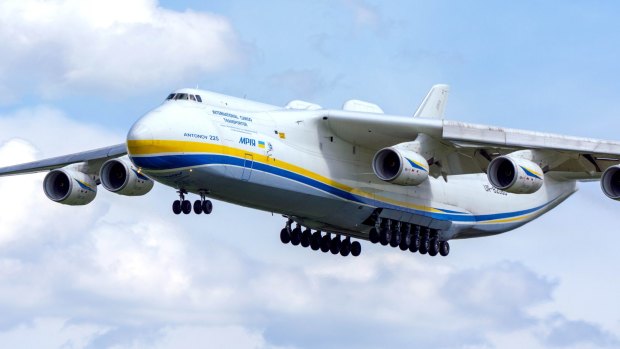This was published 3 years ago
Confirmation the world's largest plane, the Antonov AN-255, destroyed in Russia-Ukraine war
By Katherine Scott

The world's largest plane, the AN-225 Antonov Mriya, has been destroyed at an airport near Kyiv.Credit: iStock
Footage aired on Russian state TV has shown the charred remnants of the world's largest plane, Antonov AN-225.
The iconic Ukrainian cargo plane was destroyed near Kyiv, following Russia's invasion of Ukraine.
The aircraft, also called "Mriya" (meaning "Dream") by Ukrainians, was reportedly destroyed in an attack on Gostomel airport, where it had been based for repairs at the time, according to Ukraine's defence conglomerate, Ukroboronprom.
The destruction of the plane had been speculated on since late last month, after reports Gostomel airport had been damaged in fighting. The footage confirming the damage to the AN-225 first aired Friday on Russia's Channel 1, a state-owned network, before being picked up by Western media.
Exclusive visual of Destroyed worlds biggest transport aircraft An-225 "Mriya"
Following its destruction, Ukroboronprom described the plane as "the flagship of Ukrainian aviation", and stated that Mriya will be restored "at the expense of the occupant".
The video shows Russian Channel 1 correspondent Irina Kuksenkova reporting in front of the Mriya wreckage, with the recognisable yellow and blue aircraft nose still partially intact.
In the clip, Kuksenkova claims the aircraft was destroyed in Ukrainian artillery strikes.
Neither Kuksenkova's or Ukroboronprom's claims of who is responsible for the AN-225's destruction have been confirmed.
The AN-225 was conceived as a transport for the launch vehicle for the Soviet Buran space orbiters, the Soviet answer to the US space shuttle.
The Buran was being built in the western regions of the USSR but launched in the east. Since the Buran was too large to be transported by road or rail, Soviet engineers designed the AN-225, a massive aircraft that could piggyback the Buran to its launch site in Kazakhstan, and even launch the orbiter in mid-flight, a huge cost saving over ground launches.
In every respect, this is a massive aircraft. The AN-225 has six turbofan engines, 32 wheels, burns up to 20 tonnes of fuel per hour and has a maximum takeoff weight (MTOW) of 640 tonnes, 65 tonnes greater than the MTOW for an Airbus A380.
One weird facet of the Antonov is the enormously wide twin tail. Mounting a large object on top of the fuselage distorts the flow of air to the tail elevators and rudder on a single-tail aircraft, but the twin-tail design gets around this problem. The Boeing 747 that NASA uses to carry the space shuttle also sports a twin tail.
Shortly after the sole AN-225 ever built took to the air the Soviet space program faltered, a casualty of the implosion of the Soviet economy, and the AN-225 looked like becoming yet another Soviet white elephant.
Other uses for the AN-225 were proposed, including making it into a triple-deck airliner, but after a few years in mothballs the only AN-225 in existence was redesigned with a huge new cargo door and the aircraft given a fresh lease of life as a giant lifter, able to carry payloads too large and heavy for any other aircraft. In 2009 the AN-225 set a record for the largest single airlifted item, a 189-tonne generator destined for a gas power plant in Armenia.
with Michael Gebicki
Sign up for the Traveller newsletter
The latest travel news, tips and inspiration delivered to your inbox. Sign up now.